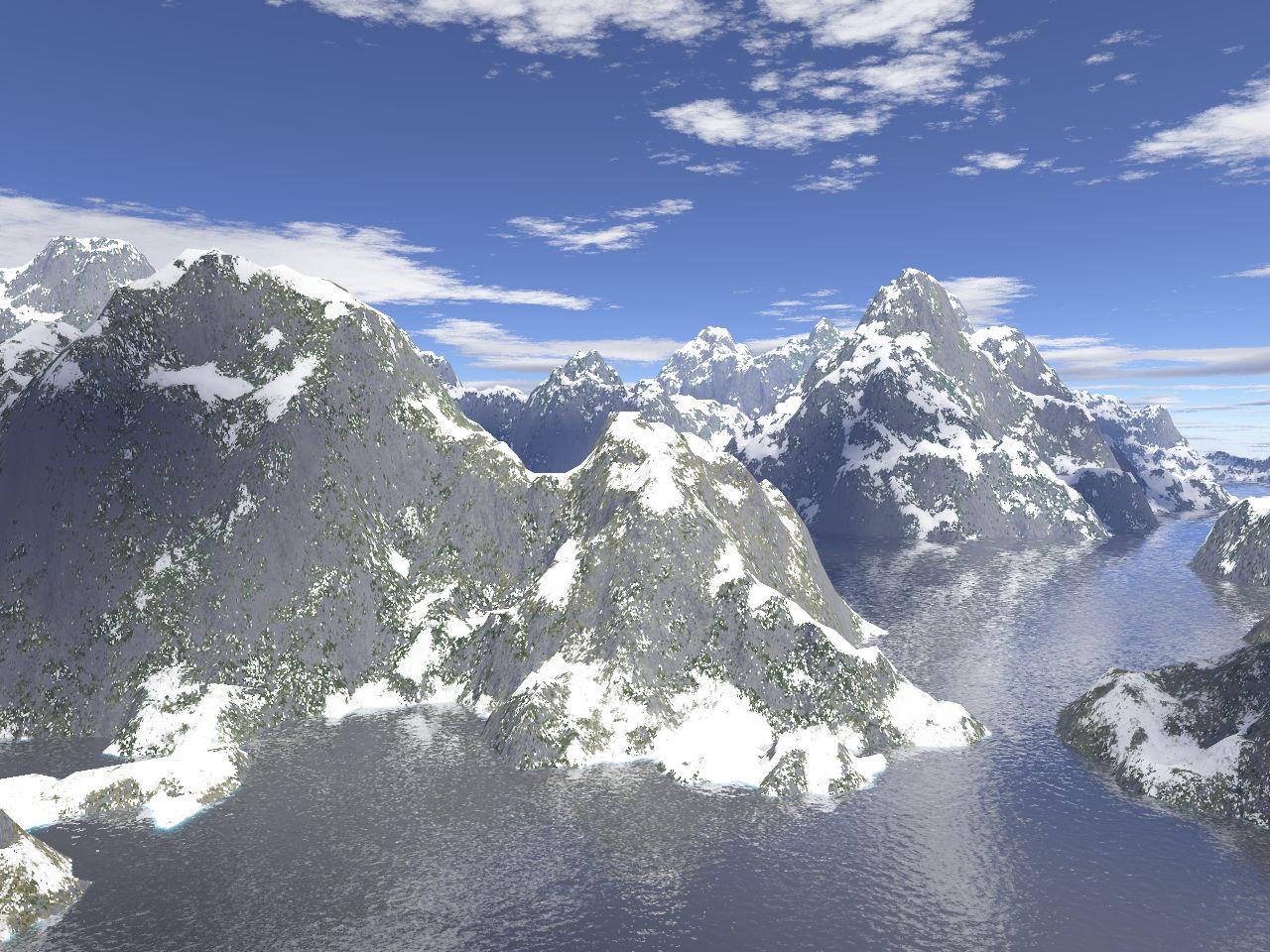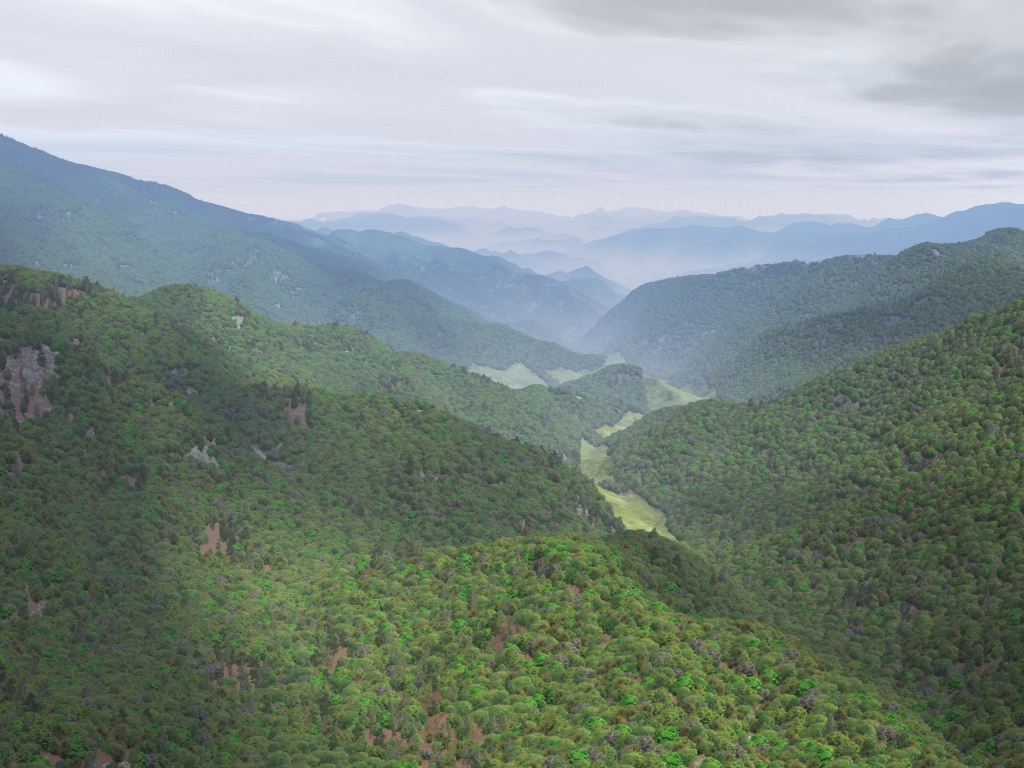Surface Fractal on:
[Wikipedia]
[Google]
[Amazon]
A fractal landscape is a surface that is generated using a
/ref> Moreover, variations in

 Whether or not
Whether or not
A Web-Wide World
by Ken Perlin, 1998; a Java applet showing a sphere with a generated landscape. {{DEFAULTSORT:Fractal Landscape Fractals
stochastic
Stochastic (, ) refers to the property of being well described by a random probability distribution. Although stochasticity and randomness are distinct in that the former refers to a modeling approach and the latter refers to phenomena themselv ...
algorithm designed to produce fractal
In mathematics, a fractal is a geometric shape containing detailed structure at arbitrarily small scales, usually having a fractal dimension strictly exceeding the topological dimension. Many fractals appear similar at various scales, as illu ...
behavior that mimics the appearance of natural terrain. In other words, the result of the procedure is not a deterministic fractal surface, but rather a random surface that exhibits fractal behavior.
Many natural phenomena exhibit some form of statistical self-similarity that can be modeled by fractal surfaces.''Advances in multimedia modeling: 13th International Multimedia Modeling'' by Tat-Jen Cham 2007 pag/ref> Moreover, variations in
surface texture
Surface finish, also known as surface texture or surface topography, is the nature of a surface as defined by the three characteristics of lay, surface roughness, and waviness.. It comprises the small, local deviations of a surface from the perf ...
provide important visual cues to the orientation and slopes of surfaces, and the use of almost self-similar fractal patterns can help create natural looking visual effects.
The modeling of the Earth's rough surfaces via fractional Brownian motion was first proposed by Benoit Mandelbrot
Benoit B. Mandelbrot (20 November 1924 – 14 October 2010) was a Polish-born French-American mathematician and polymath with broad interests in the practical sciences, especially regarding what he labeled as "the art of roughness" of phy ...
.
Because the intended result of the process is to produce a landscape, rather than a mathematical function, processes are frequently applied to such landscapes that may affect the stationarity and even the overall fractal behavior of such a surface, in the interests of producing a more convincing landscape.
According to R. R. Shearer, the generation of natural looking surfaces and landscapes was a major turning point in art history, where the distinction between geometric, computer generated images and natural, man made art became blurred. The first use of a fractal-generated landscape in a film was in 1982 for the movie '' Star Trek II: The Wrath of Khan''. Loren Carpenter refined the techniques of Mandelbrot to create an alien landscape.
Behavior of natural landscapes

 Whether or not
Whether or not natural landscape
A natural landscape is the original landscape that exists before it is acted upon by human culture
Culture () is an umbrella term which encompasses the social behavior, institutions, and norms found in human societies, as well as the kn ...
s behave in a generally fractal manner has been the subject of some research. Technically speaking, any surface in three-dimensional space has a topological dimension
In mathematics, the Lebesgue covering dimension or topological dimension of a topological space is one of several different ways of defining the dimension of the space in a
topological invariant, topologically invariant way.
Informal discussion
F ...
of 2, and therefore any fractal surface
A fractal landscape is a surface that is generated using a stochastic algorithm designed to produce fractal behavior that mimics the appearance of natural terrain. In other words, the result of the procedure is not a deterministic fractal surface, ...
in three-dimensional space has a Hausdorff dimension
In mathematics, Hausdorff dimension is a measure of ''roughness'', or more specifically, fractal dimension, that was first introduced in 1918 by mathematician Felix Hausdorff. For instance, the Hausdorff dimension of a single point is zero, of a ...
between 2 and 3. Real landscapes however, have varying behavior at different scales. This means that an attempt to calculate the 'overall' fractal dimension of a real landscape can result in measures of negative fractal dimension, or of fractal dimension above 3. In particular, many studies of natural phenomena, even those commonly thought to exhibit fractal behavior, do not do so, over more than a few orders of magnitude. For instance, Richardson's examination of the western coastline of Britain showed fractal behavior of the coastline over only two orders of magnitude. In general, there is no reason to suppose that the geological processes that shape terrain on large scales (for example plate tectonics
Plate tectonics (from the la, label=Late Latin, tectonicus, from the grc, τεκτονικός, lit=pertaining to building) is the generally accepted scientific theory that considers the Earth's lithosphere to comprise a number of large ...
) exhibit the same mathematical behavior as those that shape terrain on smaller scales (for instance, soil creep
Downhill creep, also known as soil creep or commonly just creep, is a type of creep characterized by the slow, downward progression of rock and soil down a low grade slope; it can also refer to slow deformation of such materials as a result of p ...
).
Real landscapes also have varying statistical behavior from place to place, so for example sandy beaches don't exhibit the same fractal properties as mountain ranges. A fractal function, however, is statistically stationary, meaning that its bulk statistical properties are the same everywhere. Thus, any real approach to modeling landscapes requires the ability to modulate fractal behavior spatially. Additionally real landscapes have very few natural minima (most of these are lakes), whereas a fractal function has as many minima as maxima, on average. Real landscapes also have features originating with the flow of water and ice over their surface, which simple fractals cannot model.
It is because of these considerations that the simple fractal functions are often inappropriate for modeling landscapes. More sophisticated techniques (known as 'multi-fractal' techniques) use different fractal dimensions for different scales, and thus can better model the frequency spectrum behavior of real landscapes
Generation of fractal landscapes
A way to make such alandscape
A landscape is the visible features of an area of land, its landforms, and how they integrate with natural or man-made features, often considered in terms of their aesthetic appeal.''New Oxford American Dictionary''. A landscape includes the ...
is to employ the random midpoint displacement algorithm, in which a square is subdivided into four smaller equal squares and the center point is vertically offset by some random amount. The process is repeated on the four new squares, and so on, until the desired level of detail is reached. There are many fractal procedures (such as combining multiple octaves of Simplex noise
Simplex noise is the result of an ''n''-dimensional noise function comparable to Perlin noise ("classic" noise) but with fewer directional artifacts and, in higher dimensions, a lower computational overhead. Ken Perlin designed the algorithm in ...
) capable of creating terrain data, however, the term "fractal landscape" has become more generic over time.
Fractal plants
''Fractal plants'' can be procedurally generated usingL-systems
An L-system or Lindenmayer system is a parallel rewriting system and a type of formal grammar. An L-system consists of an alphabet of symbols that can be used to make strings, a collection of production rules that expand each symbol into some ...
in computer-generated scenes.See also
* Brownian surface * Bryce *Diamond-square algorithm
The diamond-square algorithm is a method for generating heightmaps for computer graphics. It is a slightly better algorithm than the three-dimensional implementation of the midpoint displacement algorithm, which produces two-dimensional landscap ...
*Grome
''Grome'' is an environmental modeling package developed by Quad Software dedicated for procedural and manual generation of large virtual outdoor worlds suitable for games and other 3D real-time simulation applications.
History
After more tha ...
*Outerra
Outerra is a Slovak computer software company best known for its middleware 3D planetary graphics engine, called Outerra engine, in development since 2008. The engine renders high-quality terrain, terrain texturing, flora and water flow norma ...
*Terragen
Terragen is a scenery generator program for Microsoft Windows and Mac OS X developed and published by Planetside Software. It can be used to create renderings and animations of landscapes.
History
Released in stages (tech preview and beta ...
* Octree
*Quadtree
A quadtree is a tree data structure in which each internal node has exactly four children. Quadtrees are the two-dimensional analog of octrees and are most often used to partition a two-dimensional space by recursively subdividing it into four q ...
Notes
References
* * * *External links
A Web-Wide World
by Ken Perlin, 1998; a Java applet showing a sphere with a generated landscape. {{DEFAULTSORT:Fractal Landscape Fractals